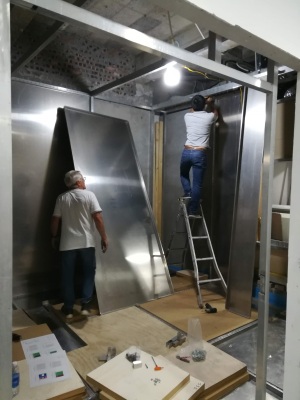por
John R. Fischer, Senior Reporter | September 28, 2020

Providers must put appropriate measures in place and have a pathway to ensure the magnet and shielding components can be easily transported into the room. (Photo courtesy of Istra Corporation)
From the September 2020 issue of HealthCare Business News magazine
One of the great things about an MR scanner is that once it’s installed, it shouldn’t be going anywhere anytime soon. That’s fortunate, considering the complicated logistics that go with getting it there in the first place.
But eventually, after many years of use, you may find yourself back in the market for a replacement scanner. When that time comes, one of the first steps should be testing the radiofrequency (RF) shield, an out-of-sight and easily forgotten barrier that allows the system to operate.
“Just because a shield that’s been there for 10 years has not created a problem for a five or ten-year-old magnet does not mean it’s still performing as it had to on day one, for many reasons,” Mike Krachon, director of sales and marketing for IMEDCO America, told HCB News. “The predominant requisite of replacing any equipment is to show the shield that has been there looks like it just came out of the box.”



Ad Statistics
Times Displayed: 123124
Times Visited: 7135 MIT labs, experts in Multi-Vendor component level repair of: MRI Coils, RF amplifiers, Gradient Amplifiers Contrast Media Injectors. System repairs, sub-assembly repairs, component level repairs, refurbish/calibrate. info@mitlabsusa.com/+1 (305) 470-8013
The most obvious sign that a shield is not attenuating correctly is when artifacts appear on the MR scans. (Photo courtesy of NELCO Worldwide)
If the shield is not operating to spec at that time, and the vast majority won’t be, then a shielding specialist will be required to get the shield to the point where it meets new equipment performance limits. Along with Krachon, HCB News sat down with a number of shielding experts to discuss the ins and outs of these vital structures, and how providers can ensure any work on them goes quickly and smoothly.
Be ready with answers
The first thing a shielding expert will need to know before evaluating an existing shield, or partnering with you on a new shield, is the make and model of your scanner. They will also want to know about the other technology being used in the MR suite, and any information you can provide concerning the site layout will also be helpful, such as construction blueprints.
“Foremost we ask for the site drawings, and if available, a complete site audit,” said Cristiano Villa, president of Istra Corporation. “Understanding the spectrum of electromagnetic interference (EMI) and RF that can affect the MR allows us to help the customer make educated decisions and address any issue before construction begins. We also inquire about future construction plans for the facility and the area.”

